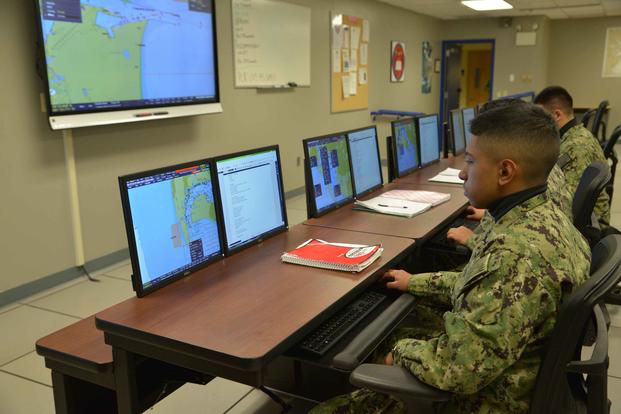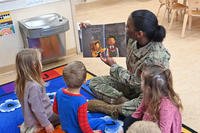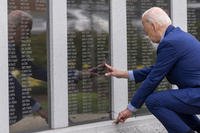When new sailors arrive at their technical schoolhouses, where they’ll spend weeks learning vital skills to help operate massive ships at sea, they’re now hit with a somber message at the very beginning.
They watch a video about two Navy destroyers, the Fitzgerald and John S. McCain. The ships were involved in separate collisions in the Pacific two years ago. Seventeen sailors died.
And the video is having an effect on some of the first sailors to go through the newly overhauled "A" school for operations specialists.
"It makes the curriculum real," Operations Specialist Seaman Joshua Orozco told reporters Wednesday. "These are very expensive and very important warships, and seeing those incidents and how simple mistakes could lead to the damages that were caused ... definitely makes it real."
Related: A Year After Deadly Collisions, Navy Still Has Dozens of Changes to Make
Orozco is one of the first operations specialists who will head to the fleet as a certified voyage-management system operator. It's part of a years-long effort to revamp the way the Navy trains sailors, giving them more hands-on practice before they're thrown into real-world tests.
The "A" School for operations specialists is the first to complete its curriculum overhaul. The effort was led by Capt. Dave Stoner, commanding officer of the Center for Surface Combat Systems, and Dean McCarty, director of training there.
Both have extensive experience aboard surface ships. Stoner served as commanding officer of the guided-missile cruiser Monterey, which last year decimated Syrian chemical sites with Tomahawk missile strikes as part of Operation Steadfast Protector.
Stoner said the findings of the investigations into the McCain and Fitzgerald collisions helped inform the training sailors heading out to serve on surface ships will get in the classroom. But those weren't the only factors that led to the A school's overhaul, he added.
"We've certainly learned a lot from that that may have accelerated different aspects of the training that we're doing," Stoner said. "But there's been a realization for a number of years that we want to get back to a better, more hands-on learning style."
The Navy's entire training system is undergoing this shift. At OS "A" school, McCarty said about 30% of the lessons used to be hands-on and 70% knowledge-based -- think looking at PowerPoint slides.
Now, that's flipped. Sailors are spending upward of three-quarters of the class getting hands-on training for their future jobs, he said.
"When we went to the computer-based training model, I saw a downward trend in the quality of the student that we were sending out to the fleet," McCarty said. "Now I feel like we're steering the correct course and getting back on track ... so we're going to deliver a much better prepared and qualified student that's going to be able to be a key member of the [combat information center] watch team."
The way the Navy trained officers and sailors to operate at sea came under intense scrutiny following the McCain and Fitzgerald collisions. Surface warfare officers did much of their training through distance learning CD-based courses known as "SWOs in a box."
Now, the 34-day OS "A" school puts new sailors in labs that simulate what they'll experience on the ship. That includes darkened rooms that look like command centers, video game-like lessons and tests that give them a lifelike view of standing watch, and computer systems just like those they'll operate on aircraft carriers and amphibious ships.
The Navy plans to add virtual reality to the mix to eventually give students an even more realistic view of what they'll face. They can also work with the course developers to alter scenarios, so students are faced with current challenges as threats change.
"Sometimes, it's hard to remember that the sailors who are sitting in this class were -- three, four months ago -- somewhere else in the country doing something completely different and not thinking about lights on a ship," Stoner said. "We've got to provide as much context as we can."
The captain said it's too early to get feedback from commanders in the fleet about the changes they're seeing in the new operations specialists' chops, but he's confident they're taking the right approach.
McCarty said he was the one who worked with the developer to get the video about the McCain and Fitzgerald collisions added to the intro.
"If I'm a young sailor who was going through OS 'A' school, I'm thinking, 'Why do I need to know this? Why do I need to pay attention in class?'" he said. "... I wanted [this] video right up in front of those 7th Fleet incidents with the McCain and Fitzgerald, so that's the hook that brings you [in]. That idea that, 'Hey, lives are at risk if you don't pay attention.'"
Even though the students weren't even in uniform yet when those accidents happened, including the video in their curriculum has had an impact.
"It definitely shows us ... that we need to report everything we see, even if it doesn't look suspicious," Operations Specialist Seaman Apprentice Raychelle Hart said.
-- Gina Harkins can be reached at gina.harkins@military.com. Follow her on Twitter @ginaaharkins.
Read more: Navy Denies Canceling Black Sea Op on Trump's Order












